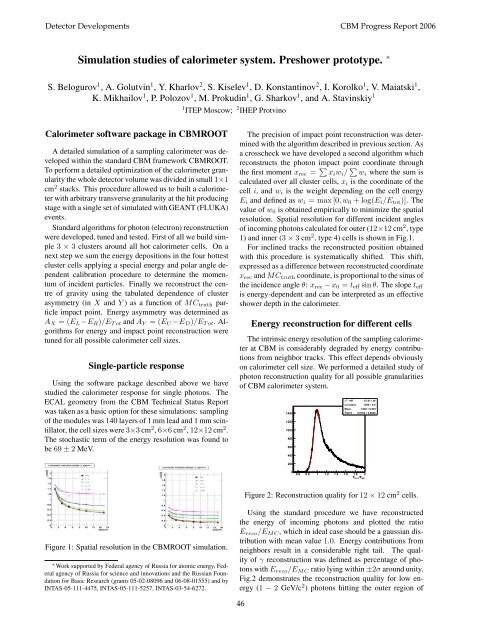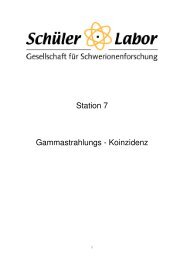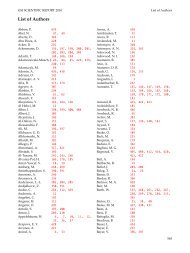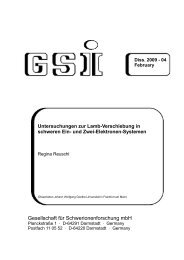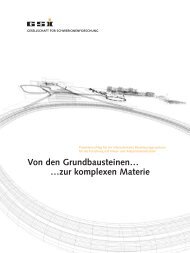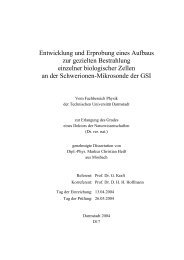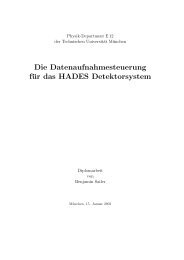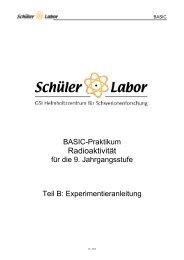CBM Progress Report 2006 - GSI
CBM Progress Report 2006 - GSI
CBM Progress Report 2006 - GSI
You also want an ePaper? Increase the reach of your titles
YUMPU automatically turns print PDFs into web optimized ePapers that Google loves.
Detector Developments <strong>CBM</strong> <strong>Progress</strong> <strong>Report</strong> <strong>2006</strong><br />
Simulation studies of calorimeter system. Preshower prototype. ∗<br />
S. Belogurov 1 , A. Golutvin 1 , Y. Kharlov 2 , S. Kiselev 1 , D. Konstantinov 2 , I. Korolko 1 , V. Maiatski 1 ,<br />
K. Mikhailov 1 , P. Polozov 1 , M. Prokudin 1 , G. Sharkov 1 , and A. Stavinskiy 1<br />
Calorimeter software package in <strong>CBM</strong>ROOT<br />
A detailed simulation of a sampling calorimeter was developed<br />
within the standard <strong>CBM</strong> framework <strong>CBM</strong>ROOT.<br />
To perform a detailed optimization of the calorimeter granularity<br />
the whole detector volume was divided in small 1×1<br />
cm 2 stacks. This procedure allowed us to built a calorimeter<br />
with arbitrary transverse granularity at the hit producing<br />
stage with a single set of simulated with GEANT (FLUKA)<br />
events.<br />
Standard algorithms for photon (electron) reconstruction<br />
were developed, tuned and tested. First of all we build simple<br />
3 × 3 clusters around all hot calorimeter cells. On a<br />
next step we sum the energy depositions in the four hottest<br />
cluster cells applying a special energy and polar angle dependent<br />
calibration procedure to determine the momentum<br />
of incident particles. Finally we reconstruct the centre<br />
of gravity using the tabulated dependence of cluster<br />
asymmetry (in X and Y ) as a function of MCtruth particle<br />
impact point. Energy asymmetry was determined as<br />
AX = (EL−ER)/ET ot and AY = (EU −ED)/ET ot. Algorithms<br />
for energy and impact point reconstruction were<br />
tuned for all possible calorimeter cell sizes.<br />
Single-particle response<br />
Using the software package described above we have<br />
studied the calorimeter response for single photons. The<br />
ECAL geometry from the <strong>CBM</strong> Technical Status <strong>Report</strong><br />
was taken as a basic option for these simulations: sampling<br />
of the modules was 140 layers of 1 mm lead and 1 mm scintillator,<br />
the cell sizes were 3×3 cm 2 , 6×6 cm 2 , 12×12 cm 2 .<br />
The stochastic term of the energy resolution was found to<br />
be 69 ± 2 MeV.<br />
Figure 1: Spatial resolution in the <strong>CBM</strong>ROOT simulation.<br />
∗ Work supported by Federal agency of Russia for atomic energy, Federal<br />
agency of Russia for science and innovations and the Russian Foundation<br />
for Basic Research (grants 05-02-08096 and 06-08-01555) and by<br />
INTAS-05-111-4475, INTAS-05-111-5257, INTAS-03-54-6272.<br />
1 ITEP Moscow; 2 IHEP Protvino<br />
The precision of impact point reconstruction was determined<br />
with the algorithm described in previous section. As<br />
a crosscheck we have developed a second algorithm which<br />
reconstructs the photon impact point coordinate through<br />
the first moment xrec = xiwi/ wi where the sum is<br />
calculated over all cluster cells, xi is the coordinate of the<br />
cell i, and wi is the weight depending on the cell energy<br />
Ei and defined as wi = max [0, w0 + log(Ei/Etot)]. The<br />
value of w0 is obtained empirically to minimize the spatial<br />
resolution. Spatial resolution for different incident angles<br />
of incoming photons calculated for outer (12×12 cm 2 , type<br />
1) and inner (3 × 3 cm 2 , type 4) cells is shown in Fig.1.<br />
For inclined tracks the reconstructed position obtained<br />
with this procedure is systematically shifted. This shift,<br />
expressed as a difference between reconstructed coordinate<br />
xrec and MCtruth coordinate, is proportional to the sinus of<br />
the incidence angle θ: xrec − x0 = teff sin θ. The slope teff<br />
is energy-dependent and can be interpreted as an effective<br />
shower depth in the calorimeter.<br />
Energy reconstruction for different cells<br />
The intrinsic energy resolution of the sampling calorimeter<br />
at <strong>CBM</strong> is considerably degraded by energy contributions<br />
from neighbor tracks. This effect depends obviously<br />
on calorimeter cell size. We performed a detailed study of<br />
photon reconstruction quality for all possible granularities<br />
of <strong>CBM</strong> calorimeter system.<br />
1400<br />
1200<br />
1000<br />
800<br />
600<br />
400<br />
200<br />
χ 2 / ndf 67.01 / 46<br />
Constant 1488 ± 8.6<br />
Mean 1.002 ± 0.001<br />
Sigma 0.0762 ± 0.0006<br />
0<br />
0.6 0.8 1 1.2 1.4 1.6 1.8 2<br />
Ereco/EMC<br />
Figure 2: Reconstruction quality for 12 × 12 cm 2 cells.<br />
Using the standard procedure we have reconstructed<br />
the energy of incoming photons and plotted the ratio<br />
Ereco/EMC, which in ideal case should be a gaussian distribution<br />
with mean value 1.0. Energy contributions from<br />
neighbors result in a considerable right tail. The quality<br />
of γ reconstruction was defined as percentage of photons<br />
with Ereco/EMC ratio lying within ±2σ around unity.<br />
Fig.2 demonstrates the reconstruction quality for low energy<br />
(1 − 2 GeV/c 2 ) photons hitting the outer region of<br />
46


